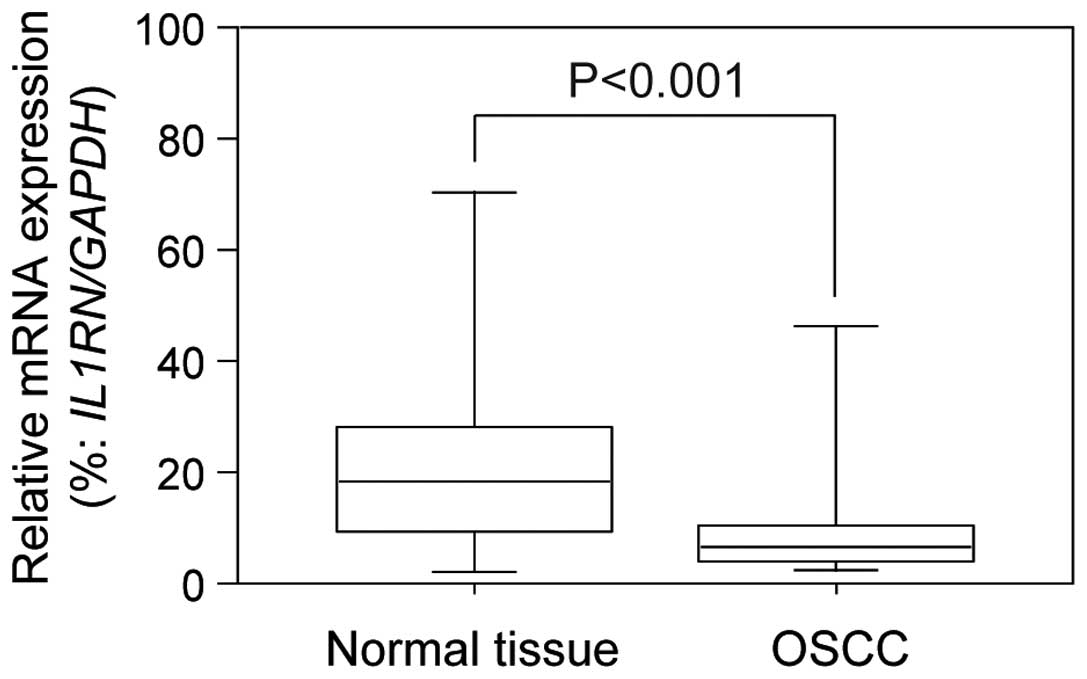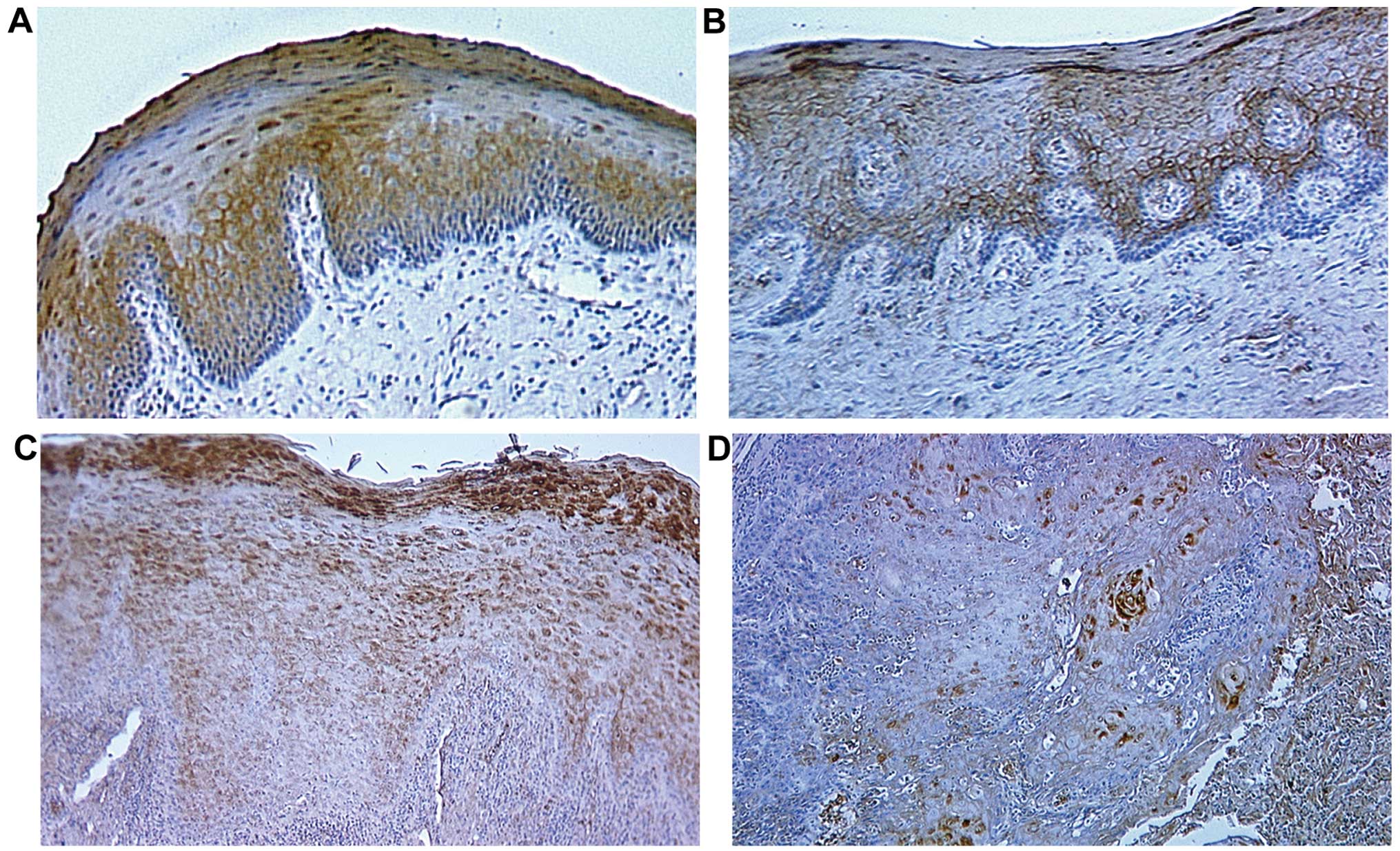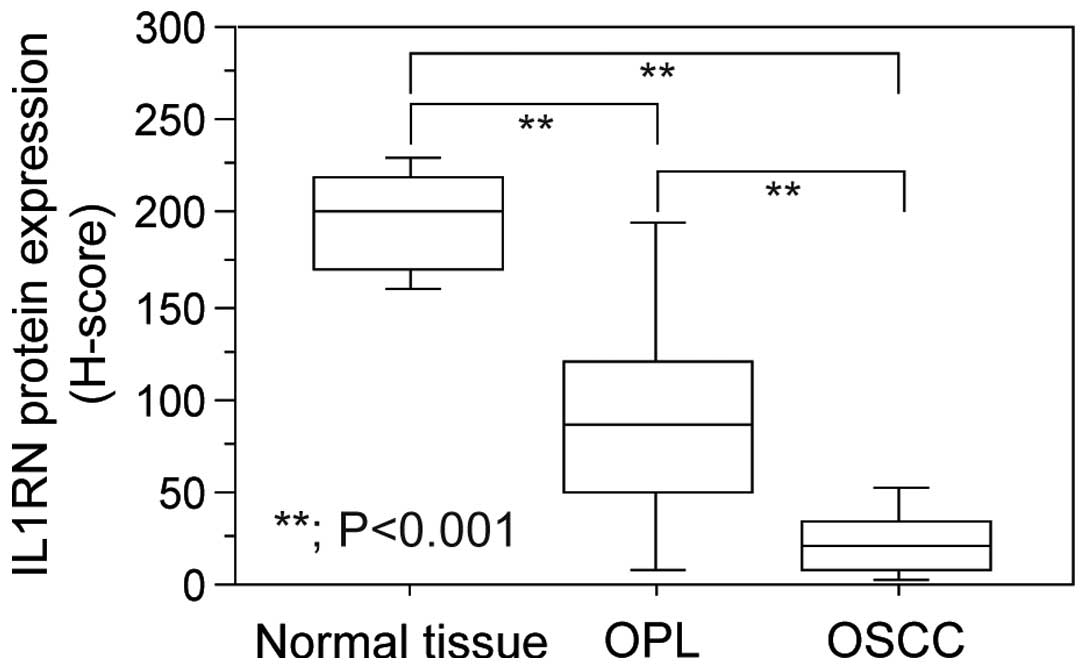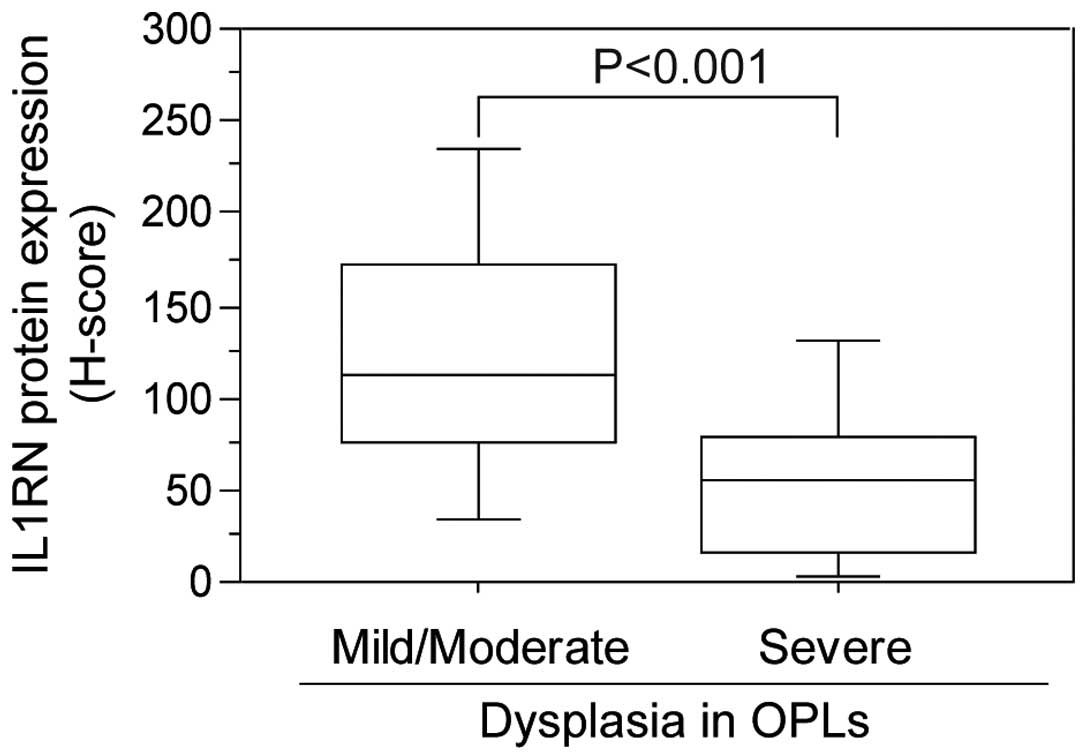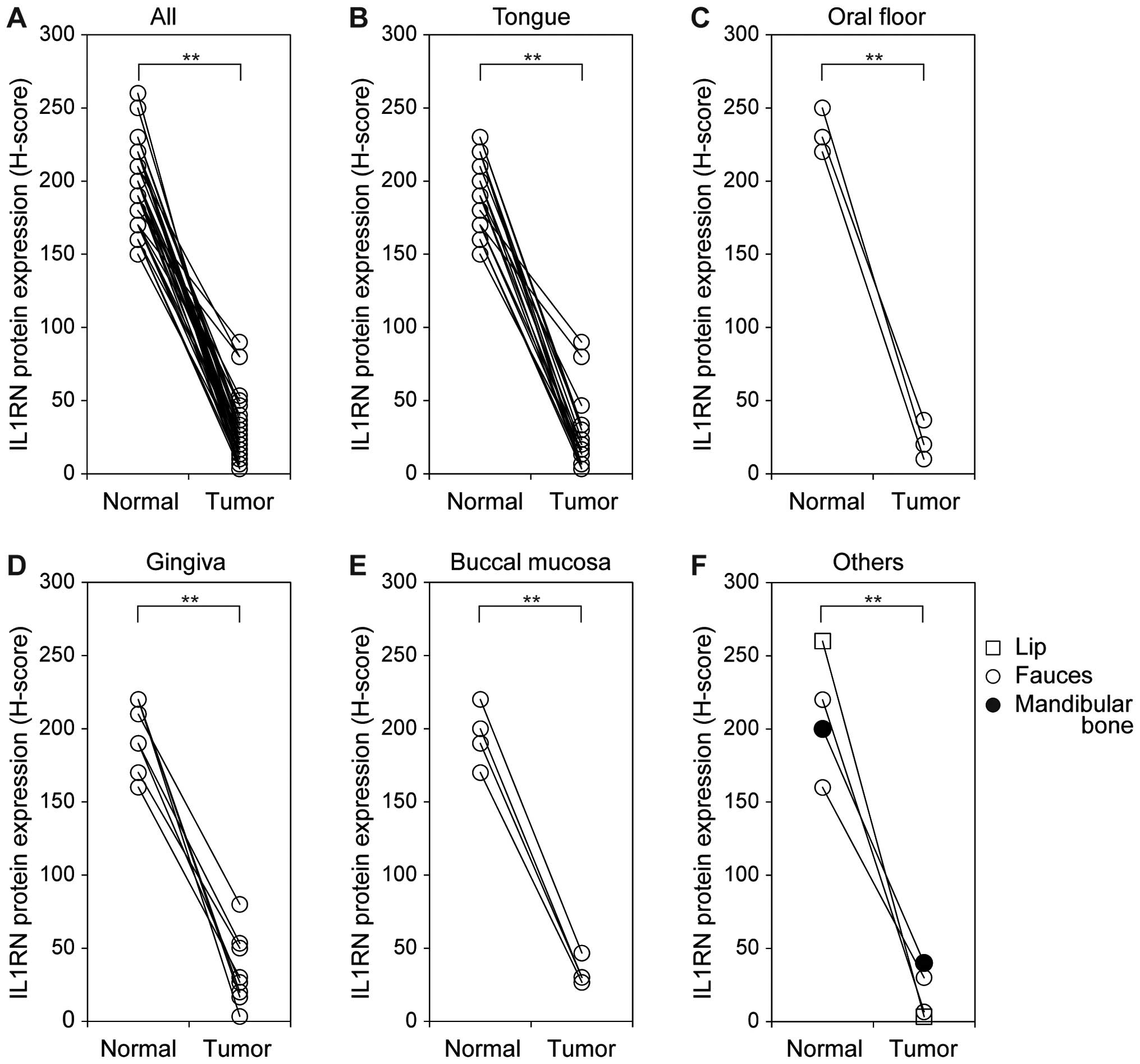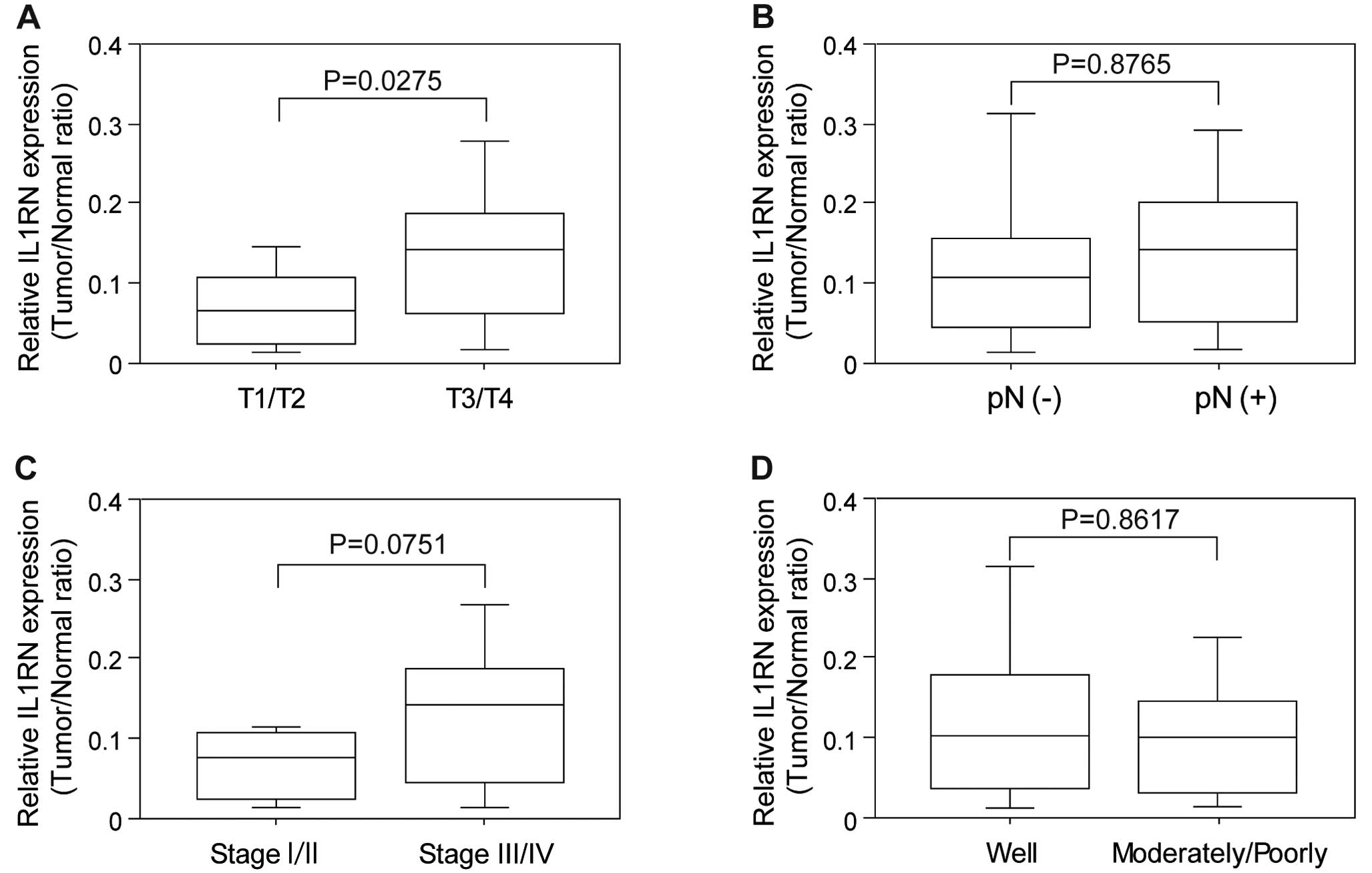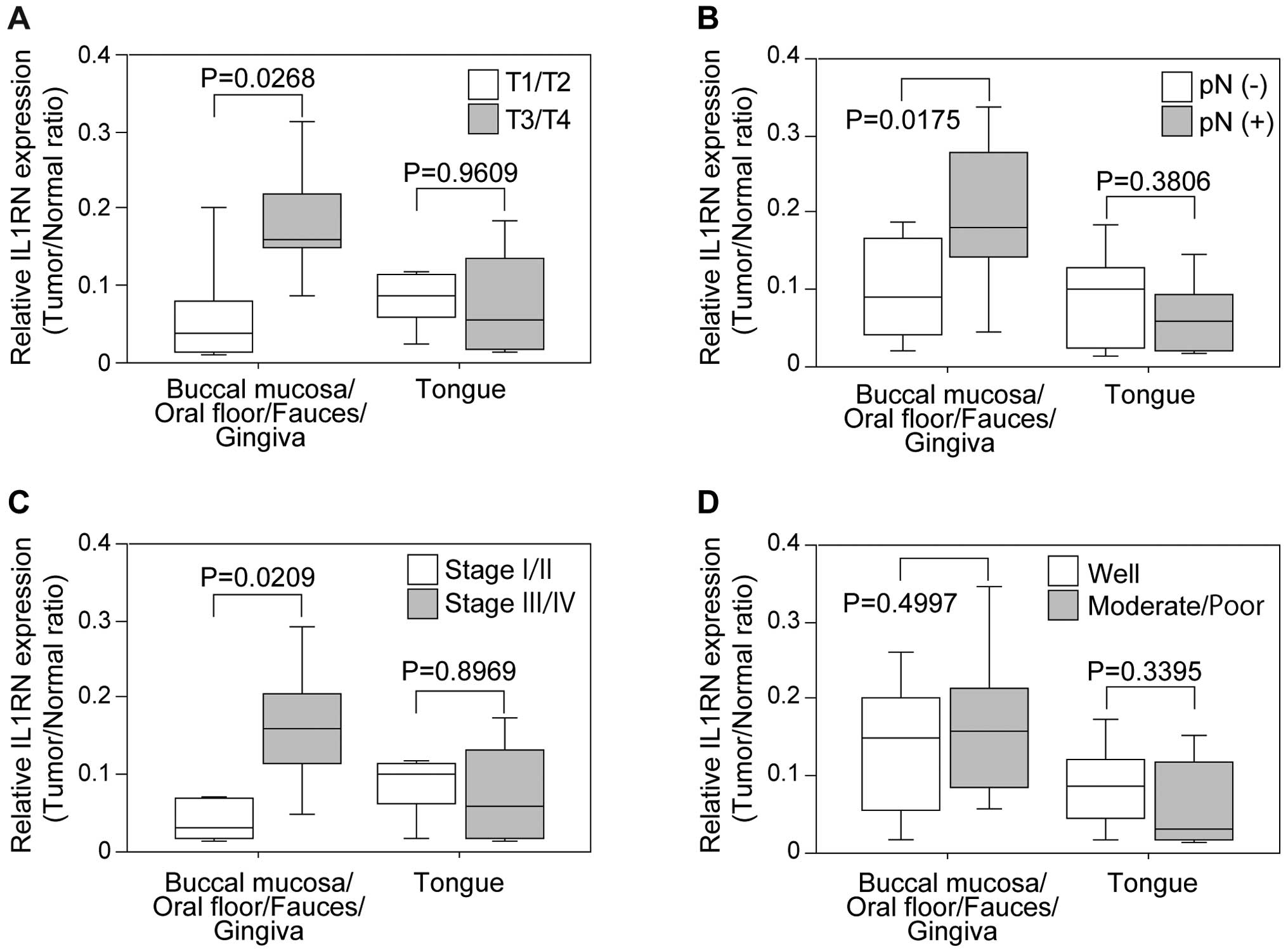|
1
|
La Vecchia C, Lucchini F, Negri E and Levi
F: Trends in oral cancer mortality in Europe. Oral Oncol.
40:433–439. 2004. View Article : Google Scholar : PubMed/NCBI
|
|
2
|
Koike H, Uzawa K, Nakashima D, Shimada K,
Kato Y, Higo M, Kouzu Y, Endo Y, Kasamatsu A and Tanzawa H:
Identification of differentially expressed proteins in oral
squamous cell carcinoma using a global proteomic approach. Int J
Oncol. 27:59–67. 2005.PubMed/NCBI
|
|
3
|
Sethi G, Shanmugam MK, Ramachandran L,
Kumar AP and Tergaonkar V: Multifaceted link between cancer and
inflammation. Biosci Rep. 32:1–15. 2012. View Article : Google Scholar
|
|
4
|
Aggarwal BB and Gehlot P: Inflammation and
cancer: How friendly is the relationship for cancer patients? Curr
Opin Pharmacol. 9:351–369. 2009. View Article : Google Scholar : PubMed/NCBI
|
|
5
|
Patel MM and Pandya AN: Relationship of
oral cancer with age, sex, site distribution and habits. Indian J
Pathol Microbiol. 47:195–197. 2004.
|
|
6
|
Znaor A, Brennan P, Gajalakshmi V, Mathew
A, Shanta V, Varghese C and Boffetta P: Independent and combined
effects of tobacco smoking, chewing and alcohol drinking on the
risk of oral, pharyngeal and esophageal cancers in Indian men. Int
J Cancer. 105:681–686. 2003. View Article : Google Scholar : PubMed/NCBI
|
|
7
|
Matsuo Y, Sawai H, Ma J, Xu D, Ochi N,
Yasuda A, Takahashi H, Funahashi H and Takeyama H: IL-1alpha
secreted by colon cancer cells enhances angiogenesis: The
relationship between IL-1alpha release and tumor cells’ potential
for liver metastasis. J Surg Oncol. 99:361–367. 2009. View Article : Google Scholar : PubMed/NCBI
|
|
8
|
Matsuo Y, Sawai H, Ochi N, Yasuda A,
Takahashi H, Funahashi H, Takeyama H and Guha S: Interleukin-1alpha
secreted by pancreatic cancer cells promotes angiogenesis and its
therapeutic implications. J Surg Res. 153:274–281. 2009. View Article : Google Scholar
|
|
9
|
Ma J, Sawai H, Matsuo Y, et al:
Interleukin-1alpha enhances angiogenesis and is associated with
liver metastatic potential in human gastric cancer cell lines. J
Surg Res. 148:197–204. 2008. View Article : Google Scholar : PubMed/NCBI
|
|
10
|
Dinarello CA: Interleukin-1 and its
biologically related cytokines. Adv Immunol. 44:153–205. 1989.
View Article : Google Scholar : PubMed/NCBI
|
|
11
|
Dinarello CA: Interleukin-1, interleukin-1
receptors and interleukin-1 receptor antagonist. Int Rev Immunol.
16:457–499. 1998. View Article : Google Scholar : PubMed/NCBI
|
|
12
|
Arend WP: Interleukin 1 receptor
antagonist. A new member of the interleukin 1 family. J Clin
Invest. 88:1445–1451. 1991. View Article : Google Scholar : PubMed/NCBI
|
|
13
|
Arend WP: The balance between IL-1 and
IL-1Ra in disease. Cytokine Growth Factor Rev. 13:323–340. 2002.
View Article : Google Scholar : PubMed/NCBI
|
|
14
|
Amagasa T, Yamashiro M and Ishikawa H:
Yamashiro M and and Ishikawa H: Oral leukoplakia related to
malignant transformation. Oral Sci Int. 3:45–55. 2006. View Article : Google Scholar
|
|
15
|
Bilalovic N, Sandstad B, Golouh R, Nesland
JM, Selak I and Torlakovic EE: CD10 protein expression in tumor and
stromal cells of malignant melanoma is associated with tumor
progression. Mod Pathol. 17:1251–1258. 2004. View Article : Google Scholar : PubMed/NCBI
|
|
16
|
McCarty KS Jr, Szabo E, Flowers JL, et al:
Use of a monoclonal anti-estrogen receptor antibody in the
immunohistochemical evaluation of human tumors. Cancer Res.
46(Suppl 8): S4244–S4248. 1986.
|
|
17
|
Lallemant B, Evrard A, Combescure C, et
al: Clinical relevance of nine transcriptional molecular markers
for the diagnosis of head and neck squamous cell carcinoma in
tissue and saliva rinse. BMC Cancer. 9:3702009. View Article : Google Scholar : PubMed/NCBI
|
|
18
|
Yamamoto N, Mizoe J, Numasawa H, Tsujii H,
Shibahara T and Noma H: Allelic loss on chromosomes 2q, 3p and 21q:
Possibly a poor prognostic factor in oral squamous cell carcinoma.
Oral Oncol. 39:796–805. 2003. View Article : Google Scholar : PubMed/NCBI
|
|
19
|
Dewberry R, Holden H, Crossman D and
Francis S: Interleukin-1 receptor antagonist expression in human
endothelial cells and atherosclerosis. Arterioscler Thromb Vasc
Biol. 20:2394–2400. 2000. View Article : Google Scholar : PubMed/NCBI
|
|
20
|
Rafiq S, Stevens K, Hurst AJ, et al:
Common genetic variation in the gene encoding
interleukin-1-receptor antagonist (IL-1RA) is associated with
altered circulating IL-1RA levels. Genes Immun. 8:344–351. 2007.
View Article : Google Scholar : PubMed/NCBI
|
|
21
|
Kurzrock R: Cytokine deregulation in
cancer. Biomed Pharmacother. 55:543–547. 2001. View Article : Google Scholar
|
|
22
|
Gherardi RK, Bélec L, Soubrier M, Malapert
D, Zuber M, Viard JP, Intrator L, Degos JD and Authier FJ:
Overproduction of proinflammatory cytokines imbalanced by their
antagonists in POEMS syndrome. Blood. 87:1458–1465. 1996.PubMed/NCBI
|
|
23
|
Iwagaki H, Hizuta A and Tanaka N:
Interleukin-1 receptor antagonists and other markers in colorectal
cancer patients. Scand J Gastroenterol. 32:577–581. 1997.
View Article : Google Scholar : PubMed/NCBI
|
|
24
|
Parekh DJ, Ankerst DP, Baillargeon J,
Higgins B, Platz EA, Troyer D, Hernandez J, Leach RJ, Lokshin A and
Thompson IM: Assessment of 54 biomarkers for biopsy-detectable
prostate cancer. Cancer Epidemiol Biomarkers Prev. 16:1966–1972.
2007. View Article : Google Scholar : PubMed/NCBI
|
|
25
|
La E, Rundhaug JE and Fischer SM: Role of
intracellular interleukin-1 receptor antagonist in skin
carcinogenesis. Mol Carcinog. 30:218–223. 2001. View Article : Google Scholar : PubMed/NCBI
|
|
26
|
Elaraj DM, Weinreich DM, Varghese S,
Puhlmann M, Hewitt SM, Carroll NM, Feldman ED, Turner EM and
Alexander HR: The role of interleukin 1 in growth and metastasis of
human cancer xenografts. Clin Cancer Res. 12:1088–1096. 2006.
View Article : Google Scholar : PubMed/NCBI
|
|
27
|
Lindahl G, Saarinen N, Abrahamsson A and
Dabrosin C: Tamoxifen, flaxseed, and the lignan enterolactone
increase stroma- and cancer cell-derived IL-1Ra and decrease tumor
angiogenesis in estrogen-dependent breast cancer. Cancer Res.
71:51–60. 2011. View Article : Google Scholar
|
|
28
|
Fujiwaki R, Iida K, Nakayama K, Kanasaki
H, Hata K, Katabuchi H, Okamura H and Miyazaki K: Clinical
significance of interleukin-1 receptor antagonist in patients with
cervical carcinoma. Gynecol Oncol. 89:77–83. 2003. View Article : Google Scholar : PubMed/NCBI
|
|
29
|
Iizuka N, Hazama S, Hirose K, Abe T,
Tokuda N, Fukumoto T, Tangoku A and Oka M: Interleukin-1 receptor
antagonist mRNA expression and the progression of gastric
carcinoma. Cancer Lett. 142:179–184. 1999. View Article : Google Scholar : PubMed/NCBI
|
|
30
|
Oelmann E, Kraemer A, Serve H, Reufi B,
Oberberg D, Patt S, Herbst H, Stein H, Thiel E and Berdel WE:
Autocrine interleukin-1 receptor antagonist can support malignant
growth of glioblastoma by blocking growth-inhibiting autocrine loop
of interleukin-1. Int J Cancer. 71:1066–1076. 1997. View Article : Google Scholar : PubMed/NCBI
|
|
31
|
Hsieh TC and Chiao JW: Growth modulation
of human prostatic cancer cells by interleukin-1 and interleukin-1
receptor antagonist. Cancer Lett. 95:119–123. 1995. View Article : Google Scholar : PubMed/NCBI
|
|
32
|
Yamada Y, Karasaki H, Matsushima K, Lee GH
and Ogawa K: Expression of an IL-1 receptor antagonist during mouse
hepato-carcinogenesis demonstrated by differential display
analysis. Lab Invest. 79:1059–1067. 1999.PubMed/NCBI
|
|
33
|
Dvorkin T, Song X, Argov S, White RM,
Zoller M, Segal S, Dinarello CA, Voronov E and Apte RN: Immune
phenomena involved in the in vivo regression of fibrosarcoma cells
expressing cell-associated IL-1alpha. J Leukoc Biol. 80:96–106.
2006. View Article : Google Scholar : PubMed/NCBI
|
|
34
|
Voronov E, Weinstein Y, Benharroch D, et
al: Antitumor and immunotherapeutic effects of activated invasive T
lymphoma cells that display short-term interleukin 1alpha
expression. Cancer Res. 59:1029–1035. 1999.PubMed/NCBI
|
|
35
|
Al-Dakkak I: Oral dysplasia and risk of
progression to cancer. Evid Based Dent. 11:91–92. 2010. View Article : Google Scholar : PubMed/NCBI
|
|
36
|
Liu W, Bao ZX, Shi LJ, Tang GY and Zhou
ZT: Malignant transformation of oral epithelial dysplasia:
Clinicopathological risk factors and outcome analysis in a
retrospective cohort of 138 cases. Histopathology. 59:733–740.
2011. View Article : Google Scholar : PubMed/NCBI
|















